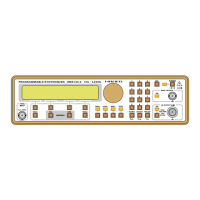16
Subject to change without notice
Commands supported
General
There are two kinds of commands. The first one is the set of
old commands which are HM8133-2 compatible. They are
normally understood by the instrument without changing
existing programs. The second one is a new set with a similar
syntax to the SCPI standard. We recommend to use these
commands which are the only one described hereafter.
Description
Commands are sent by lines to the instrument, one line being
a set of characters in ASCII code between 20 and 127 (dec),
and terminated by an end of line terminator (10 dec) or 13
following by 10 (dec).Each line is composed of one or several
simple commands (elementary) separated one another by the
«;» (comma) separator.
Example: :POWER 7 ; :FREQ 500E+6 ; :OUTP ON
The level is at +7dBm , the frequency at 500MHz and the
output signal ON. The strings of data are not case sensitive.That
means lower case and upper case are the same.A simple
command gives an access to a quantity or a function of the
instrument. All commands acting on the same quantity are
brought together syntaxicaly in a tree structure. We are going
to detail function by function beginning with the simplest and
the usefulest.
Commands description
Preliminary conventions
In the lines below, we use the following conventions:
- lower cases in keywords are optional, meaning for example
that the keyword «OUTPut» may be employed as OUTP
(short writing) or OUTPUT (long writing).
- [] means that the keyword in brackets is optional.
- | means «exclusive or» between several parameters.
- a NR1 number is a string of digits without decimal point
(1234).
- a NR2 number is a string of digits with a decimal point
(1234.56).
- a NR3 number is a string representing a decimal number
with an exposant (1234.56E+3).
Initialisation
*RST*RST
*RST*RST
*RST idem key «ESC» at power on time except beep, display,
com and memory config (0-9) which are not modified
General commands
*IDN? identification
*SAV x store current state (x from 0 to 9)
*RCL x recall configuration (x from 0 to 9)
SNR? serial number
FAB? manufacture date
Bus commands
LK0 local mode enable
LK1 local mode disable
RM0 local mode
RM1 remote mode
Sound commands
BP0 Beep off
BPS soft Beep
BPL loud Beep
Commands tree - OUTPUT
It brings together commands for switching the RF output
signal.
Syntax:
:OUTPut[:STATe] 0 | OFF | 1 | ON (1)
:OUTPut[STATe]? (2)
The line (1) allows you to change the state , the parameters
«0» or «OFF» are equivalent and turn the output off, «1» or
«ON» turn the output on. The line (2) asks the output state to
the instrument. It always sends back «1» for output ON and
«0» for output OFF.
Examples:
:OUTP ON Ouput ON.
:OUTP 1 Same as above.
:OUTPUT ON Same as above.
:OUTPUT:STATE 1 Same as above.
:OUTP? Asks the ouput state.
:OUTPUT:STATE? Same as above.
Commands tree - POWER
It summarizes the commands for changing the level of the RF
output signal.
Syntax:
:POWer[:LEVel] <NUM> (1)
:POWer[:LEVel]? (2)
:POWer:UNIT V | DBM (3)
:POWer:UNIT? (4)
The line (1) allows you to modify the level, the <NUM>
parameter is a NR2 number in the range covered by the
instrument. None unit must follow the number, the current
unit is assumed. The line (3) allows you to change the current
unit. Two parameters are possible : V for Volt (mV/uV included),
or DBM for dBm.
The line (4) asks the current unit to the instrument. It sends
back the same strings as the corresponding command
parameters above. The line (2) asks the current level to the
instrument. It sends back a NR2 number corresponding to the
resolution without the unit.
Examples:
:POW:UNIT DBM Set the level unit dBm
:POWER:UNIT DBM Idem
:POW 5.7 Set the level … 5.7 dBm
:POW:LEV 5.7 Idem ...
:POWER:UNIT? Ask the unit
Commands tree - FREQUENCY
It summarizes the commands about the signal (carrier)
frequency.
Operation - Commands description

